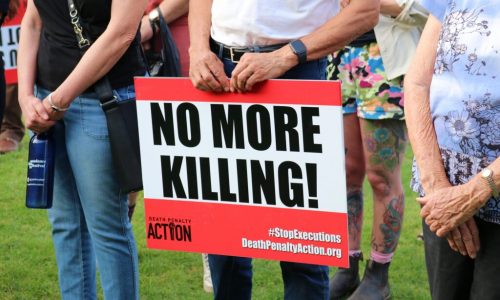By Gloria Gomez/UA Don Bolles Fellow/AZ Mirror
PHOENIX — Khalil Rushdan knows firsthand what a prison looks like during an execution. In 1997, he was hard at work in the kitchen of an Arizona prison the day it happened.
“That day was the only day that it was silent. Everybody in that yard knew what was going on,” he said.
On Wednesday morning, Clarence Dixon was executed for murdering university student Deana Bowdoin. Groups advocating the end of the death penalty held a vigil for Dixon at the state Capitol on Tuesday afternoon ahead of the execution, and denounced the practice which has seen an 8 year hiatus.
The death penalty, opponents argued, disproportionately affects minorities — and Dixon, who is Navajo, is a clear example. Bruce Franks Jr., a community organizer for Mass Liberation Arizona, said capital punishment has been falsely marketed as justice for victims, when in reality it continues the legacy of systemic racism in the justice system.
“The death penalty has never been and can never be a viable solution for harm or the loss of life. Capital punishment is nothing more than a violent, racist tool of white supremacy,” he said. “Death is not justice.”
Minorities, especially Black people, make up a disproportionate share of the total number of death row inmates in the country; 34% of those executed since 1976 have been Black, despite representing only about 13% of the national population. The Prison Policy Initiative, a criminal justice think tank, found that receiving a death penalty sentence is four times likelier for a Black defendant than a white one.
Mikki Hovel, who is also Navajo, donned a black and white shirt with an image of Geronimo on it, with the word “Resist” in bright white lettering above it. She expressed concern over the outsized representation of Native Americans on death row in Arizona. Dixon was one of five Native Americans awaiting execution.
“We’re such a small population,” she said.
Hovel also said that a person with debilitating mental health issues — Dixon was diagnosed with schizophrenia — shouldn’t be put to death by the state. Life imprisonment, in Dixon’s case, would be preferable, she said.
Ron Friesen, a licensed professional counselor, echoed this. Friesen said that Dixon’s schizophrenia, which is severe enough to render him disabled and causes him to be a danger to himself and others, played a key role in his conviction.
Before Bowdoin was killed, Dixon was found not guilty due to insanity in an assault case, and determined to be both schizophrenic and depressed. The state’s failure to commit him to a hospital, Friesen said, made it as much a part of Bowdoin’s murder as Dixon.
“Mr. Clarence Dixon, at the hand of the State of Arizona, will pay with his death for the failures of the mental health and judicial systems of the state of Arizona,” he said.
Even Dixon’s 2008 death penalty sentence represented injustice on the part of the state, Friesen said, given that Dixon was allowed to represent himsel despite being unfit to do so.
Attempts by the states to implement capital punishment are all flawed, said Dale Baich, a retired public defender with 33 years of experience representing people on death row. Invariably, those efforts will result in miscarriages of justice. Since 1973, 321 people have been sentenced to death — and just over 50% of them have had those sentences vacated.
In Arizona alone, 10 people who were given a death sentence were later exonerated, Baich said.
Despite the signs that capital punishment causes more harm than good, the option persists, and critics say that’s because of its value on the campaign trail.
“Every time you have an election cycle, you have individuals who want to capitalize on this ‘get tough on crime’ mentality,” said Rushdan, who is also an organizing director for the Arizona chapter of the American Civil Liberties Union.
Attorney General Mark Brnovich, for example, has been a strong proponent of the death penalty as a way to gain votes for his bid for U.S. Senate, Rushdan said. Franks added that this was despite championing himself as a pro-life candidate.
For people who have been through the system because of mistakes made when they didn’t know better, a harsh and irreversible punishment like the death penalty should be taken off the table entirely. Cat Castaneda was 19 when she was booked for assault, and she didn’t regain her freedom until 15 years later. Now, she’s a retired electrician who volunteers with the ACLU, advocating for restored voting rights.
“I’ve seen entirely too many people who made mistakes when they were younger, and seen a good many of them turn their lives around,” she said. “I don’t think anyone has the right to take anyone else’s life.”
Gloria Gomez, a senior at the University of Arizona, is the 2022 UA School of Journalism’s Don Bolles Fellow working with editors from the Arizona Mirror. Gomez has interned at the Arizona Daily Star and worked at the Arizona Daily Wildcat. She is a dual major in journalism and political science, with a Spanish minor. She’s a member of the Investigative Reporters and Editors and National Association of Hispanic Journalists. The UA School of Journalism started the fellowship in 1977 to honor Don Bolles, an Arizona Republic reporter killed in a 1976 car bombing.

